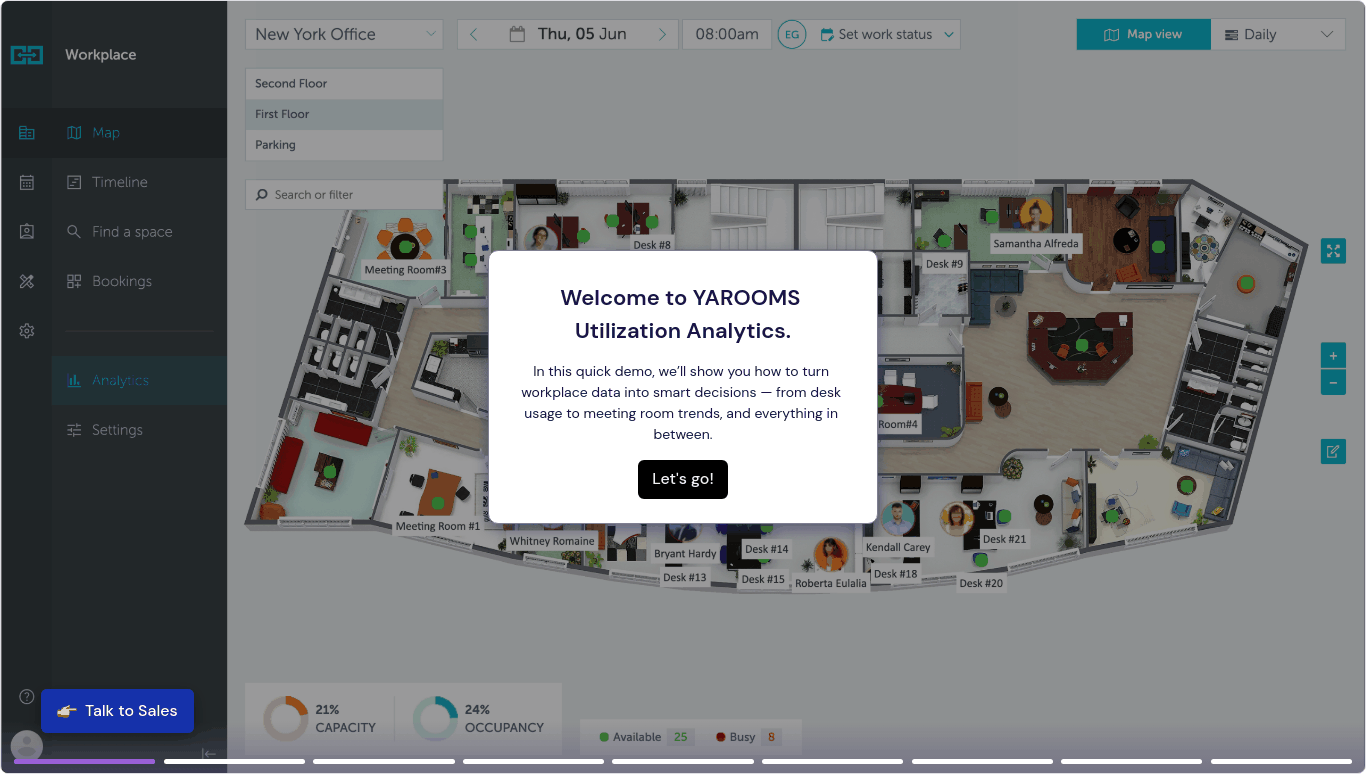There's a clear shift in the world of work. More and more people are telecommuting or co-working, making empty office spaces increasingly more common.
It's not just an illusion, numbers stand as testimony for the winds of change. If at the end of 2019, US office vacancy rate was only 11.4%, this number has been steadily increasing since 2020. In Q1 2023, it reached 16.1%, with some markets pointing to a 30.9% office vacancy rate (in Dallas, Texas, for example.)
All hope is not lost, though. If you are a property manager or a commercial real estate owner intrigued (or downright worried) by the large vacant buildings, you need to know repurposing is not just possible, but actually recommended.
How to do it?
Let's take a closer look at ten practical strategies for breathing new life into and efficiently repurposing empty office space.
TL;DR:
- "Empty office space" refers to unoccupied areas in commercial buildings designed for professional use.
- Reasons for vacant offices include remote work acceleration, economic downturns, real estate challenges, technological shifts, and urban migration.
- Empty office spaces impact employees, causing reduced cohesion, motivation, and increased stress.
- Financial implications include ongoing costs, depreciation, and lost revenue potential.
- Strategies to maximize occupancy: flexible workspaces, virtual services, incubation centers, event hosting, subleasing, learning centers, co-retail spaces, entertainment areas, arts/culture centers, and indoor greenhouses.
- Future possibilities involve residential conversions, flexible work environments, sustainability initiatives, PropTech innovations, and spaces for employee well-being.
- Addressing the challenge requires innovative repurposing and adapting to changing work and real estate trends.
Empty Office Space: An Overview
"Empty office space" is a term increasingly familiar to many business owners and property managers — a term that refers to unoccupied square footage within commercial buildings initially designed for professional use. The decline in demand for traditional office space is a result of these factors.
This can encompass entire dormant edifices known as abandoned office buildings, partial segments within active structures (referred to as vacant), and even unused areas in otherwise bustling cities.
There are various factors that contribute to the upward trend in such vacancies, but recent technological advancements and economic constraints play significant roles here. Plus, transformations in employment demographics and the emergence of hybrid work have propelled this phenomenon even further.
If you plan to convert empty offices into functional utility hubs, you need to start by understanding their anatomy: what they are, what they were built for, what happened, and how to move forward.
As we dissect the intricate issue of the growing number of unused office spaces, remember that each idle square foot represents untapped potential - waiting for innovative ideas to revive its dormant existence.

What Are the Reasons Behind Empty Offices?
We shouldn't fool ourselves: the recent surge in office building vacancies in major metropolitan areas is far from a simple issue. It's a complex equation fueled by several key factors – and finding solutions can only happen if you understand the underlying reasons and address them, rather than enforce "return to office" mandates that only deepen the chasm between employers and employees.
Remote Work at Super-Speed
Remote work wasn't born in 2020 – but 2020 fast-forwarded us into a scenario where everyone who used to work in an office had to take their office... home (at least for a while.)
Three years later, companies are still transitioning to remote work models at an unprecedented scale. According to UpWork, about 28% of the US workforce will be remote by the end of 2028, a prediction that has changed from the 22% that was foretold in 2020.
This situation has sparked discussions about the end of office space as we know it since employees no longer require large office spaces to perform their duties efficiently. Companies are now finding ways to utilize extra office space created by remote work trends, such as subleasing to other businesses or repurposing for collaborative work environments.
The Looming Recession
Secondly, businesses have been downsizing due to economic strife and as part of their deliberate strategies to decrease square-foot office space requirements.
Operating multiple small office buildings split across various locations can be more cost-efficient than maintaining one big building, so it makes sense that Facility Managers are asked to "do more with less" and buckle up for a seemingly imminent recession.

The Real Estate Crisis
The real estate crisis has also played a significant role in increasing the number of empty offices. Companies have opted for leasing instead of purchasing commercial real estate due to financial constraints imposed by challenging economic times.
As a result, there is a growing number of commercial properties that are vacant and stand as silent testimony to an era gone by. This has led to an increase in unused space, presenting opportunities for monetization through renting to other businesses or using it as storage space.
Technological Innovations
Paradoxically, innovations within tech sectors that continue pushing towards creating flexible coworking spaces have become vacant in some traditional commercial office spaces.
These modern workspace solutions provide flexibility in lease terms and payments, making them an attractive option over static commercial real estate offices.
Urban Migration
Lastly, it's essential not to neglect urban migration trends contributing towards abandoned office buildings. The rush by businesses towards prime city locations led to a surplus of large office space in less-desirable areas being left unused or unrented.
All of these elements make for a scenario that seems hard to reverse. Yet, as mentioned in the beginning, hope isn't lost – on the contrary, the entire situation can be an opportunity to not just "do more with less", but do better.

Impact of Empty Office Space on Employees
Empty office spaces don't affect the economy and business owners only.
They affect the people who spend one third of their working days in these spaces too.
A deserted workplace with empty space can lead to unexpected consequences for staff members. Predominantly, they may experience a perceived lack of cohesion and teamwork due to vacant offices adjoining their workspace.
Under such circumstances, collaborative synergy, critical in today's work environment, can dwindle drastically.
The effects stretch beyond mere team dynamics too. Witnessing constant "For Lease" signs in various segments of their office building can sow seeds of insecurity among employees. They might start questioning the organization's stability or its future plans – and when you consider the massive wave of layoffs that made headlines in 2022 and 2023, it's easy to see how employees may have lost their trust in employers.
Moreover, large unoccupied office spaces can affect employees' day to day operations and productivity levels – and in significant ways too:
Disrupted Workflow
The regular flow of information exchange may get hampered due to wide gaps created by empty offices. Navigating around redundant space intervals can make even simple collaborations seem daunting.
Lowered Morale
Employee motivation is significantly influenced by their environment – an ecosystem bustling with action often aids morale, while vacant office buildings do the reverse.
The result? Only 6% of employees with low morale say they aren't planning to leave their current job soon. Considering employee turnover can cost up to one-third of their base annual salary and that onboarding new employees is time and energy-consuming, it's easy to see why you want your current employees to stick around.

Increased Stress
A domino effect might ensue as stress levels rise parallelly with insecurities fueled by persistent emptiness in commercial real estate offices. A stressed employee is an unproductive one – and multiple studies prove it. So, as a business owner or Human Resources manager, you want to make sure your employees are as stress-free as possible – and that includes prioritizing their wellbeing, retention, and meeting their expectations.
Aesthetic Displeasure
Lastly, abandoned office buildings are far from aesthetically pleasing - a factor that plays a pivotal role in boosting workplace satisfaction rates. It might seem like a trifle (compared to everything else), but office aesthetics can:
- Boost creativity
- Enhance mood and
- Even drive engagement.
Financial Implications of Empty Office Space
There are substantial financial implications in the discussion around empty office space.
The monetary effects linked to unused commercial real estate are paramount, especially considering the present reality of a potential real estate crisis looming in many regions.
When you own or lease a square-foot office space that remains vacant for some time, you're essentially incurring unnecessary expenses with no returns on your investment. These costs may include maintenance fees, utilities, insurance premiums, property taxes, and management fees, which remain constant regardless of whether the space is occupied.
This static expenditure isn't the only concern when dealing with idle office developments, though. An empty office space left underutilized for lengthy durations can lead to depreciation in its market value.
Moreover, another noteworthy consideration is lost opportunity cost- the revenue you could have made if your large office space had been leased out compared to what you currently make (which could very well be zero). Essentially, empty offices translate into potentially lost profits.
On a broader scale, the persistent presence of abandoned office buildings impacts negatively on local economies too. Commercial properties pay considerable annual property tax revenues that help fund public services, and maintaining community standards. Hence these prevalent big office buildings standing unoccupied are bad news for us all.
Overall, being stuck with a commercial office building that's constantly vacant creates financial strain, individually or corporately, while also having detrimental economic ripples within communities.
Understanding these implications will help you devise effective strategies to maximize office occupancy leading to healthier returns on investments and bolstering local economies.

Top 10 Strategies to Maximize Office Occupancy
Optimal use of your empty office space can significantly increase productivity and enhance overall business efficiency. Here are ten creative strategies to best equip your vacant office buildings with utility and purpose.
Flexible Working Space
Transforming sections of your large office space into flexible co-working areas is an excellent option. This setup caters to freelancers, startups, and even larger organizations looking for short-term workspace solutions. It can drive revenue, stimulate networking opportunities, and foster a culture of collaboration.
Virtual Office Services
Another viable strategy involves providing virtual services such as address registration or postal mail routing for remote workers. By catering to those who prefer working from their homes yet need office-related services, you breathe new life into your empty office buildings.
Business/ Tech Incubation Center
Converting unused square foot office space into incubation centers or accelerators fosters innovation within the hub. Such spaces bolster emerging businesses by offering needed logistical support, potential mentorship, networking opportunities, and a stimulating environment conducive to growth.
Event Hosting
If yours is one of those big office buildings coupled with aesthetic appeal, consider hosting corporate events or seminars occasionally. Not only does it translate idle commercial real estate into resourceful meeting arenas, but it also promotes an interpersonal exchange between professionals across various industries.

Subleasing Workspaces
Last on this list could include renting out desk spaces or separate rooms to independent entrepreneurs desiring small but inspiring work havens distinct from their home environment. This approach efficiently repurposes your commercial office building while supporting self-starting initiatives. Additionally, subleased workspaces can be used for private events such as meetings and parties, catering to the growing demand for clean and versatile venues post-pandemic.
Learning Centers
Opening a learning center that offers courses in professional development or creative skills is an efficient way to revive your empty office buildings. It also helps build community ties and encourages informal exchange between members of the workforce.
Co-Retail Space
Co-retail spaces are shared retail centers where independent businesses can collaborate, network, showcase their products and even collaborate with like-minded entrepreneurs. It is a great way to utilize empty office buildings as vibrant hubs of business activities. Additionally, these co-retail spaces can also serve as storage spaces for businesses, providing a practical solution for those in metropolitan areas where storage space is often limited.
Entertainment Space
Why not turn your empty office space into an entertainment center for employees working there? Nothing says "we care about you" better than providing people with a way to spend their time off in a fun, stimulating environment. Allowing employees to join the entertainment space and maybe even bring their families to special events (like movie projections) will foster a sense of belonging and loyalty.
Arts/ Culture Centre
For large corporate office buildings that aim to tap into local cultures, establishing a cultural centre can be an effective way to address the issue of empty office space. This could include hosting regular art exhibitions, live music events, theatre performances etc., thus contributing towards fostering creativity and providing a platform for emerging local talent through one of your properties.
Indoor Greenhouses
Given the escalating concerns of global warming, bringing nature indoors is an excellent way to not only utilize empty office spaces but also promote a healthier environment. Constructing indoor greenhouses in your office allows for year-round cultivation of fresh organic produce while providing employees with a refreshing break from their desks.
These strategies offer unique ways to repurpose vacated office buildings while fostering a sense of community and resourceful utility. When implemented correctly, they can help you build an inclusive, vibrant ecosystem that discounts the negative implications of large commercial real estate.
Each adjustment you implement has a two-fold effect: benefiting both parties involved - yourself (by maintaining efficient use of empty office space) and others (who gain access to helpful resources that might otherwise not be affordable or available.)
Always remember that versatility combined with creativity proves instrumental when maneuvering through the uncertain terrains presented by today's commercial real estate crisis.

The Future of Office Space
The future of office space seems ambiguous and unpredictable, but empty office spaces provide immense untapped potential. A shift in how we view and use these vacant precincts is about to unfold.
One perspective considers converting commercial office buildings into residential apartments or mixed-use facilities. This could address the wasted square foot office space problem and housing shortages in many cities worldwide.
Another wave emphasizes flexible working environments. Empty offices present the perfect opportunity for establishing coworking spaces or shared workplaces. By taking advantage of this trend, owners of large office spaces can diversify their offers and respond effectively to changing market needs.
Furthermore, environmental sustainability has been increasingly integrated into work buildings' design plans. Green initiatives, including renewable energy features, water recycling systems, and natural light optimization, are promising strategies that lead commercial real estate toward a more sustainable and profitable future.
Interestingly, innovative tech startups have begun eyeing empty office buildings as ideal locations for experimenting with various concepts collectively known as 'PropTech'. These may include advancements in area analytics or creating smarter building management systems.
Finally, there's an increased focus on employee mental health and wellbeing at workplaces. Non-conventional use of vacant office spaces like fitness centers or therapeutic zones can enhance workplace culture significantly while making efficient use of underutilized infrastructure.
While it's indeed a challenging situation with economic implications caused by the widespread prevalence of empty offices today, agile repurposing strategies foretell a future wherein every square foot is accounted for–and innovatively utilized!
Space Booking Systems and Workplace Analytics
Modernizing your space management with desk reservation and meeting room booking systems can revolutionize how you utilize available spaces in a commercial building. These systems enable efficient use of resources by allowing employees to reserve a desk or a room for work purposes or even short-term needs like pop-ups or event spaces. Moreover, they provide critical workplace analytics, shedding light on space utilization patterns and offering data-driven insights for optimizing layouts, repurposing underused areas, or adopting flexible work arrangements.
For property managers and business owners, these solutions are a valuable tool to maximize the financial health of their operations by making empty commercial spaces more attractive and functional for tenants or interested parties. By embracing such technologies, you can enhance the flexibility and appeal of your commercial space while improving its value and aligning with the needs of modern business operations.
Click the image for a full look at YAROOMS space utilization analytics. ⬇️
Conclusion
Empty office space can be a significant challenge – one we may not have ever dealt with at such a scale before.
However, the entire situation also offers an exceptional opportunity for creativity and innovation. The rise of vacant office buildings highlights the harsh reality of our current commercial real estate crisis.
We can start solving this complex office space puzzle by utilizing strategies to maximize occupancy or repurposing these office developments.
The opportunities for transforming your empty office space are almost limitless – from retail to leisure venues, state-of-the-art co-working spaces to residential conversions. We must not perceive vacant office space as mere square foot office space left untouched but in the broader context of community engagement and urban regeneration.
Examining why our working habits have led to such a surplus of empty offices is just as vital. As more companies adopt remote work models, there's an inevitable impact on large-scale commercial property occupancy rates.
In these times of change and uncertainty, one thing remains clear: ignoring the problem won't make it disappear. That puts employers and building owners at risk financially when they can do so much: think beyond conventionality and repurpose their empty offices' architecture instead.
Looking towards the future, it's essential to adapt quickly to changing trends within the work and real estate world - be it through technological advancements or shifts in social attitudes towards traditional working environments. After all, transformation begins with growth, and we must adapt effectively to thrive amidst disruptions.












